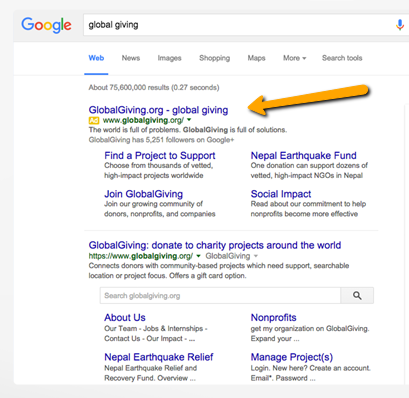We had a charity that came to us looking to manage their AdWords account. They had an aggressive budget and wanted us to drive more phone calls to their help hotline. They were getting good results, but wanted to improve their reach and impact.
We introduced them to Google Ad Grants. They were already spending a significant amount on PPC ads, but weren’t aware they could actually get a $10,000 per month credit from Google to pay for some of this. When marketing non-profits, this kind of thing is our job satisfaction — an opportunity to really make an impact for clients with our work and change lives in the process.
What is an Ad grant?
Google Ad Grants are a special program under AdWords that offers specific non-profit organizations a chance to post ads on Google absolutely free. The grant provides the non-profit with a maximum of $10,000 per month of AdWords credit, which can then be spent on a pay per click basis on the Google search engine. It is a great program and can significantly help a non-profit’s marketing budget.

How to qualify for an ad grant from Google AdWords
It goes without saying that the Ad Grants from Google are worth looking into. That $120,000 per year of ad exposure can make a significant impact, especially for smaller charities with very tight budgets. Your organization simply needs to apply and become eligible in order to receive the grant. Below are the qualification criteria used by Google to identify the beneficiaries:
1. The organization should be recognizable as a current and valid charity
Qualification as a charitable organization varies from country to country. However, to be considered eligible for the Google Ad grant your organization needs to be recognized as legal, current and valid in the specific country of origin.
2. It should have a live, relevant and up-to-date website
The website acts as the landing page from the ad, and it needs to be live at all times. Once you turn on your ad traffic, now you’ve got a nice flow of visitors in which you can optimize and improve your site. Keeping it updated and relevant, testing different landing pages and trying to improve your call to action on site will all have a positive impact in your Ad Grant campaign results.
3. It should be a non-governmental organization
Only private organizations qualify for the grant.
4. It should acknowledge and agree to Google’s terms and conditions
There are many of these including Google’s right to withdraw the grant and to reserve service. The organization needs to understand them and comply in order to qualify. These are fairly straight forward.
Do’s and Don’ts for non-profits using the Google AD grants
Getting the ad grant from Google AdWords is just the first step for the non-profit organization. To maintain your grants, the grantees are required to stick to a certain set of rules of conduct to maintain eligibility and to continue enjoying the benefits. Below are a few Do’s and Don’ts for non-profits that are lucky enough to land the grant.
· DO keep your AdWords account active. Log in frequently and make changes. The campaign needs to be actively maintained by you or a PPC management agency.
· DON’T use any other website as a landing page from your ad other than the one you registered during your application.
· DO keep the keywords in your ad relevant to what your organization represents and aims at achieving.
· DON’T use the ads to promote commercial agenda and try to sell any products or services that are not a direct part of your non-profit. The grant covers organizations trying to create awareness and get support through things like volunteers and donors.
Tips on how to use Google Ad Grants to your advantage
Below are a few foolproof tips for non-profits on how to make the most out of the Google Ad Grants;
1. Divide and conquer by splitting different campaigns into different ads
Having different ads for different project helps increase the ad’s visibility by making it more specific. Ensure that each ad is linked to the specific theme of keywords with a relevant page on the website to convert the clicks into actual actions instead of having them ignored.
2. Balance keywords and negative keywords
Think about the most relevant keywords to your mission. Use Google’s keyword suggestion tool to help come up with an appropriate list (this is where a good PPC agency can be most effective…there are a lot of mistakes made in keyword selection. Additionally, there are negative keywords. Negative keywords tell Google not to display your ad when that keyword is used in a search query. This can help improve traffic quality and your use of your monthly budget.
3. Include call to action options
Ads for non-profit organizations are often geared at creating awareness. However, for those also interested in recruiting donors and volunteers, a good call to action in both your ad and the landing page can help to make the most out of the Ad Grants. These include things like online registration and direct call links that help create a relationship between the organization and other interested parties. Always track these key points of engagement on site with your Google Analytics. Knowing what keywords succeed and which fail is vital to improving your Ad Grants account. A PPC management agency will always start with working on your tracking.
4. Constantly measure and monitor the ad’s performance
We are constantly looking to improve results. AdWords isn’t an easy out-of-the-box advertising solution. That’s why the client mentioned above came to us in the first place. They were getting good results, but wanted to be better.
In fact, if you are new to AdWords, out of the gates, the results can often be mediocre. It’s that optimization after launch that makes or breaks success. You want to constantly improve your conversion rates, ad click through rates, ad copy through split tests, keywords and a host of other tactics.
Whether you do all this yourself or hire a PPC agency, work smart, work hard on get the most from your $10K a month. The better you spend that grant, the more impact your non-profit can make in people’s lives.







